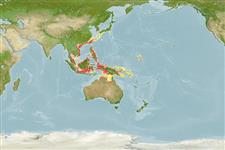>
Blenniiformes (Blennies) >
Blenniidae (Combtooth blennies) > Blenniinae
Etymology: Plagiotremus: Greek, plagios = oblique + Greek, trema = hole (Ref. 45335).
More on author: Gill.
Environment: milieu / climate zone / depth range / distribution range
Ecologia
marino demersale; distribuzione batimetrica 46 - 70 m (Ref. 7401). Tropical
Western Pacific: Irian Jaya, Indonesia, Philippines, China, Viet Nam, and Thailand.
Size / Peso / Age
Maturity: Lm ? range ? - ? cm
Max length : 17.4 cm SL maschio/sesso non determinato; (Ref. 7401)
Short description
Morfologia | Morfometria
Spine dorsali (totale): 10; Raggi dorsali molli (totale): 58-60; Spine anali 2; Raggi anali molli: 55 - 57. Yellowish brown head and body; greyish brown dorsal and anal fin; dorsal fin membranes with numerous tiny black spots; pale yellow pectoral fin with black spot on upper base; yellow caudal fin with black upper margin and black filamentous outer lobes. Segmented caudal rays 11; adults of both sexes with elongate and filamentous caudal fin outer lobes (much longer in males (up to 50% of SL); dentary incisors with arrowhead-shaped tips; 4 interorbital pore; body depth ca. 20-22 in SL. Maximum size to 27 cm TL (Ref. 90102).
Adults are found in muddy sand bottoms (Ref. 90102). Oviparous. Eggs are demersal and adhesive (Ref. 205), and are attached to the substrate via a filamentous, adhesive pad or pedestal (Ref. 94114). Larvae are planktonic, often found in shallow, coastal waters (Ref. 94114).
Life cycle and mating behavior
Maturità | Riproduzione | Deposizione | Uova | Fecundity | Larve
Oviparous, distinct pairing (Ref. 205).
Smith-Vaniz, W.F., 1987. The saber-toothed blennies, tribe Nemophini (Pisces: Bleniidae): an update. Proc. Acad. Nat. Sci. Philad. 139:1-52. (Ref. 7401)
IUCN Red List Status (Ref. 130435)
Threat to humans
Harmless
Human uses
Informazioni ulteriori
Age/SizeAccrescimentoLength-weightLength-lengthLength-frequenciesMorfometriaMorfologiaLarveDinamica popolazioni larvaliReclutamentoAbbondanzaBRUVS
BibliografiaAcquacolturaProfilo di acquacolturaVarietàGeneticaElectrophoresesEreditarietàMalattieElaborazioneNutrientsMass conversion
CollaboratoriImmaginiStamps, Coins Misc.SuoniCiguateraVelocitàModalità di nuotoArea branchialeOtolithsCervelliVista
Strumenti
Special reports
Download XML
Fonti Internet
Estimates based on models
Preferred temperature (Ref.
123201): 23.7 - 28.6, mean 27.5 °C (based on 154 cells).
Phylogenetic diversity index (Ref.
82804): PD
50 = 0.5005 [Uniqueness, from 0.5 = low to 2.0 = high].
Bayesian length-weight: a=0.00102 (0.00046 - 0.00225), b=3.06 (2.88 - 3.24), in cm total length, based on all LWR estimates for this body shape (Ref.
93245).
Trophic level (Ref.
69278): 4.8 ±0.9 se; based on size and trophs of closest relatives
Resilienza (Ref.
120179): Medio, tempo minimo di raddoppiamento della popolazione 1.4 - 4.4 anni (Preliminary K or Fecundity.).
Fishing Vulnerability (Ref.
59153): Low vulnerability (11 of 100).
